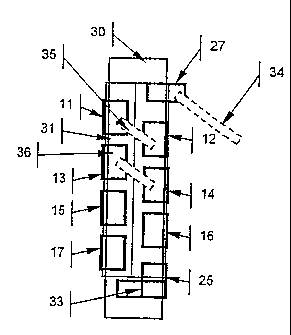Some of the information on this Web page has been provided by external sources. The Government of Canada is not responsible for the accuracy, reliability or currency of the information supplied by external sources. Users wishing to rely upon this information should consult directly with the source of the information. Content provided by external sources is not subject to official languages, privacy and accessibility requirements.
Any discrepancies in the text and image of the Claims and Abstract are due to differing posting times. Text of the Claims and Abstract are posted:
| (12) Patent Application: | (11) CA 2582251 |
|---|---|
| (54) English Title: | THERMAL RELEASE |
| (54) French Title: | DECLENCHEUR THERMIQUE |
| Status: | Deemed Abandoned and Beyond the Period of Reinstatement - Pending Response to Notice of Disregarded Communication |
| (51) International Patent Classification (IPC): |
|
|---|---|
| (72) Inventors : |
|
| (73) Owners : |
|
| (71) Applicants : |
|
| (74) Agent: | MARKS & CLERK |
| (74) Associate agent: | |
| (45) Issued: | |
| (86) PCT Filing Date: | 2005-10-06 |
| (87) Open to Public Inspection: | 2006-05-18 |
| Examination requested: | 2010-06-16 |
| Availability of licence: | N/A |
| Dedicated to the Public: | N/A |
| (25) Language of filing: | English |
| Patent Cooperation Treaty (PCT): | Yes |
|---|---|
| (86) PCT Filing Number: | PCT/EP2005/010748 |
| (87) International Publication Number: | WO 2006050775 |
| (85) National Entry: | 2007-03-29 |
| (30) Application Priority Data: | ||||||
|---|---|---|---|---|---|---|
|
The invention relates to a thermal tripping device which is heated indirectly
by means of a heating winding (10) and which comprises a release strip made of
thermostatic bimetal (30), a form memory alloy or similar. An insulating
intermediate layer (31) is arranged between the heating winding and the
release strip and one of the ends of the heating winding is connected to a
supply conductor. The heating winding is embodied in an identically meandering
manner for all current intensities and is folded about the insulating
intermediate layer. In order to modify the resistance of the heating winding
for other current intensities, the discharge (34) is connected to a wiring
point between the ends of the heating windings.
L'invention concerne un déclencheur thermique de surintensité chauffé indirectement au moyen d'un enroulement chauffant (10), ce déclencheur comprenant une lame de déclenchement réalisée dans un matériau thermique bimétallique (30), un alliage à mémoire de forme ou similaire. Une couche intermédiaire isolante (31) est placée entre l'enroulement chauffant et la lame de déclenchement et une des extrémités de l'enroulement chauffant est reliée à un conducteur d'alimentation. L'enroulement chauffant se présente en forme de méandre de façon identique pour toutes les intensités de courant et il est plié autour de la couche intermédiaire isolante. Pour modifier la résistance de l'enroulement chauffant pour d'autres intensités de courant, la dérivation (34) est raccordée à un point de prise entre les extrémités de l'enroulement chauffant.
Note: Claims are shown in the official language in which they were submitted.
Note: Descriptions are shown in the official language in which they were submitted.

2024-08-01:As part of the Next Generation Patents (NGP) transition, the Canadian Patents Database (CPD) now contains a more detailed Event History, which replicates the Event Log of our new back-office solution.
Please note that "Inactive:" events refers to events no longer in use in our new back-office solution.
For a clearer understanding of the status of the application/patent presented on this page, the site Disclaimer , as well as the definitions for Patent , Event History , Maintenance Fee and Payment History should be consulted.
| Description | Date |
|---|---|
| Time Limit for Reversal Expired | 2012-10-09 |
| Application Not Reinstated by Deadline | 2012-10-09 |
| Deemed Abandoned - Failure to Respond to Maintenance Fee Notice | 2011-10-06 |
| Inactive: Abandoned - No reply to s.30(2) Rules requisition | 2011-09-19 |
| Inactive: S.30(2) Rules - Examiner requisition | 2011-03-18 |
| Amendment Received - Voluntary Amendment | 2011-01-17 |
| Letter Sent | 2010-06-23 |
| Request for Examination Received | 2010-06-16 |
| All Requirements for Examination Determined Compliant | 2010-06-16 |
| Request for Examination Requirements Determined Compliant | 2010-06-16 |
| Letter Sent | 2007-09-06 |
| Inactive: Single transfer | 2007-07-04 |
| Inactive: Cover page published | 2007-06-01 |
| Inactive: Courtesy letter - Evidence | 2007-05-29 |
| Inactive: Notice - National entry - No RFE | 2007-05-25 |
| Inactive: First IPC assigned | 2007-04-24 |
| Application Received - PCT | 2007-04-23 |
| National Entry Requirements Determined Compliant | 2007-03-29 |
| Application Published (Open to Public Inspection) | 2006-05-18 |
| Abandonment Date | Reason | Reinstatement Date |
|---|---|---|
| 2011-10-06 |
The last payment was received on 2010-09-24
Note : If the full payment has not been received on or before the date indicated, a further fee may be required which may be one of the following
Please refer to the CIPO Patent Fees web page to see all current fee amounts.
| Fee Type | Anniversary Year | Due Date | Paid Date |
|---|---|---|---|
| Basic national fee - standard | 2007-03-29 | ||
| MF (application, 2nd anniv.) - standard | 02 | 2007-10-09 | 2007-03-29 |
| Registration of a document | 2007-07-04 | ||
| MF (application, 3rd anniv.) - standard | 03 | 2008-10-06 | 2008-09-25 |
| MF (application, 4th anniv.) - standard | 04 | 2009-10-06 | 2009-09-25 |
| Request for examination - standard | 2010-06-16 | ||
| MF (application, 5th anniv.) - standard | 05 | 2010-10-06 | 2010-09-24 |
Note: Records showing the ownership history in alphabetical order.
| Current Owners on Record |
|---|
| ABB PATENT GMBH |
| Past Owners on Record |
|---|
| THOMAS NEUBAUER |